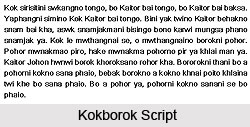 Kokborok language is the native language that is spoken by the Borok people belonging to the state of Tripura. This East Indian tribal language is also spoken in the neighbouring country of Bangladesh. The term `Kok-borok` is actually a compound of the main words and these are `kok` that literally means `language, and `borok` that means `nation`. But interestingly, the second word is used to denote the Borok people who belong to Tripura. Thus, in simple terms, it can be said that Kokborok literally means `the native language of the Borok people`. Kokborok language has been present in several forms. The Kokborok script was known as `Koloma`. The history of the Borok Kings was originally written down in Kokborok language by using the Koloma script. Later on, this book was translated into Sanskrit language and again the chronicle was translated into Bengali language. Kokborok was related to the dialect of common people during Borok King`s rule in Tripura. In the year 1979, Kokborok language was documented as the official language of the state of Tripura.
Kokborok language is the native language that is spoken by the Borok people belonging to the state of Tripura. This East Indian tribal language is also spoken in the neighbouring country of Bangladesh. The term `Kok-borok` is actually a compound of the main words and these are `kok` that literally means `language, and `borok` that means `nation`. But interestingly, the second word is used to denote the Borok people who belong to Tripura. Thus, in simple terms, it can be said that Kokborok literally means `the native language of the Borok people`. Kokborok language has been present in several forms. The Kokborok script was known as `Koloma`. The history of the Borok Kings was originally written down in Kokborok language by using the Koloma script. Later on, this book was translated into Sanskrit language and again the chronicle was translated into Bengali language. Kokborok was related to the dialect of common people during Borok King`s rule in Tripura. In the year 1979, Kokborok language was documented as the official language of the state of Tripura.
Kokborok language belongs to the Tibeto-Burman language family that is a sub-group of the Sino-Tibetan language group. It is the chief language family of East Asian and South East Asian regions. Kokborok language is closely associated with the Bodo language as well as the Dimasa language that are hugely spoken in the state of Assam. Further, Kokborok is also related to Garo language, which is principally spoken in the neighbouring country that is Bangladesh.
In Kokborok language, the letter `w` is used as a sign for a vowel that actually does not exist in English language. Moreover, in this language, `N` is considered as the pronunciation of nasal sound. Majority of the words in Kokborok language are formed by combining the source with an affix. Basically, there are two tones in this tribal language. There is a high tone as well as there is a low tone. In order to mark the high tone in this language, letter h is added with the vowel that symbolizes high tone. The Borok nation actually comprises several communities as well as sub-communities in Tripura, Mizoram and Assam. They have their own dialects that differ from one another.
The communities and their main dialects are mentioned below -
•Debbarma, Western
•Reang, Eastern and South-eastern
•Darlong, part of North
•Koloi
•Molsom
•Tripura, South
•Jamatia, South
•Rupini
Some of the Tripuri cultural organisations have been working effectively towards the development of the Kokborok language.



















